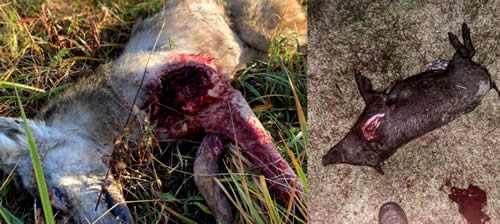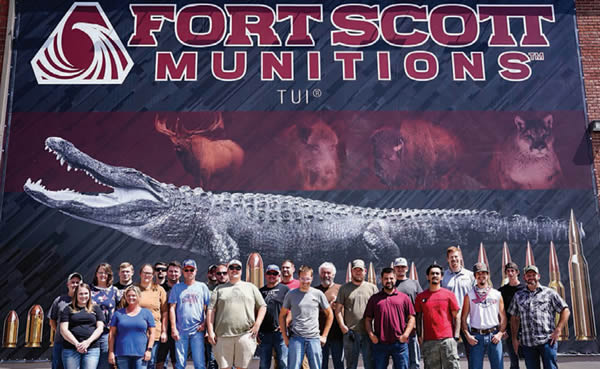Musing on Fort Scott’s Munitions
Kansas company’s deadly .300 Blackout, 5.56 NATO Tumble Upon Impact rounds get thumbs up.
Story and Photos by Paul Pawela
for Tumble Upon Impact – is one of several
unique rounds from the company that come
with solid testimonials, per author Paul Pawela.
Last month in this column, I wrote about the Battleline Tactical and Fort Scott Munitions close-quarter training course, held at the latter’s facility in Fort Scott, Kansas. I was then asked my thoughts on Fort Scott’s ammunition, which I will discuss in this article.
But before I pontificate on the company’s product line, I had planned to write an article on the poor
performances of some of the leading law enforcement rounds. Hollow points are advertised as mushrooming bullets excellent at stopping bad guys. However, most of the time this is simply not true.
I was sent an in-depth medical report by a trusted friend, who happens to be an ER surgeon and a
federal tactical officer/nationally-recognized firearms trainer. He has pulled lots of bullets from actual
bodies on the operating table and the top bullets failed to mushroom as advertised; he supplied the pictures of those bullets to back it up. Before I get crucified by the keyboard commandos for criticizing
their favorite ammo, first let me state for the record that I do not claim to be an expert on wound ballistics.
However, the same could be said for most people, including said keyboard commandos.
Even the FBI has little expertise on the matter. Here is what they had to say on the subject in their Handgun
Wounding Factors and Effectiveness” report: “There is no valid, scientific analysis of actual shooting results in existence, or being pursued to date …
There are some well publicized, so called analyses of shooting incidents being promoted, however, they are greatly flawed. Conclusions are reached based on samples so small that Most research on wound ballistics comes from coroner reports based on autopsies of said reports, as well as doctors who perform emergency procedures on gunshot victims. Then we have police reports, though these may be tainted for one reason or another.
TO DESTROY OR kill an animal, including humans, there are only two ways to do so:
1) A shot to the central nervous system, or CNS. The CNS controls all bodily functions. No part of the body can function without a signal transmitted through the CNS. Gunshot wounds to the CNS oer the best chance for reliable incapacitation; however, there is not a 100-percent guarantee that this will be quickly
achieved.
2) A shot to the brain and the medulla oblongata. The brain is small but not as difficult to hit as many state. At close range, it is often hit with remarkable results. The medulla oblongata brain stem lies between the
brain and the top of the spinal column; while a hard target to hit, if achieved it offers immediate body incapacitation.

Kansas company’s ammunition. (FORT SCOTT MUNITIONS)
With handgun ammunition, incapacitation will generally come from hypovolemic shock, which is caused by a loss of blood volume sufficient to drop blood pressure to critical levels. Bottom line, it could take a while to bleed out and die. This could be very problematic if an individual is shot but still capable of hostile action.
Animals – especially the two-legged variety – are capable of sustaining phenomenal punishment while
persisting in a determined course of action. Consider Emmett Dalton, who was one of the Dalton Gang shot in a Coffeyville, Kansas, attempted bank robbery in 1892. He was shot 23 times – two of the bullets taken from his body were large-caliber rifle bullets; others ranged from buckshot to pistol bullets – and lived!
Rifle ammunition is always better to use in a defensive encounter due to rifle projectiles traveling at higher
velocities than handgun projectiles.
Rifle projectiles also penetrate the skull much easier and create a significant hydrostatic shock wave to the body. Experts will agree that whether it be handgun or rifle ammunition, penetration is critical and so is shot placement, also known as accuracy.
SOME MAY SAY I went a long way around the barn to introduce Fort Scott Munitions fortscottmunitions.com), but the above information was necessary to understand what makes Fort Scott
different from other brands on the market and why.
First, for the record, I am not impressed with bullets being shot into gel blocks because gel blocks don’t run, dodge, duck and weave when being shot. What is important to me is how animals react to bullets when being shot. Ryan Kraft is the brainchild behind Fort Scott Munitions. While his family made it big in the printing business, being an avid hunter, Kraft started to notice certain things that were happening on the hunt.
“When hunting, which is testing on live animals, we quickly realized that projectiles that pass through the
animal greatly increases the possibility of the one-shot stop,” he said. “But for the times it didn’t drop the animal in one shot to the ‘vitals,’ it ran shorter distances before the animal became incapacitated than it did for rounds that stopped in the animal.”
He continued, “With the TUI (Tumble Upon Impact) round, we saw increased to better odds because it utilizes both principles of doing extreme terminal damage inside the animal but still exits with little energy
left. But by far the worst one-shot stops where the animals survived longer before incapacitation was fragmenting ammo that stops in the body. This was scary because at certain feet per second this is what the 5.56 is banking on to make more lethal, which in return is less lethal than if it would tumble once and not fragment. With TUI you get at least two tumbles by design and two holes to bleed through as well.”
I AM A big fan of the 5.56x45mm NATO round as both a home-defense and hunting bullet. However, with
testimonials from my former special operations friends and hunting friends, I am thoroughly convinced that .300 Blackout is the way to go. I am even more convinced that Fort Scott’s .300 Blackout ammunition could be a game-changer, especially for the law enforcement community, as no other company is getting the results that their .300 Blackout ammo is.
I will back that with testimonials from men I not only know and respect, but men I would trust with my very
life. Bill Stasak, training partner and owner of WJS Guns in Merritt Island, Florida, had this to say: “I sell and use the Fort Scott .300 Blackout round in the hunting arena; whether using their .300 AAC 115-grain standard TUI or the 190-grain AAC subsonic TUI, you are sure to take down any hog or deer with one well-placed shot.”
He added, “When using the 190-grain .300 AAC Blackout Solid Copper Spun Sub-Munition with a suppressed rifle for hogs, this round is ultra-quiet and devastating to the hog. One round drops larger hogs in their tracks and leaves the other hogs confused because the round is so quiet, the other hogs have no idea where the danger is coming from.”
If this ammo works so well on 300-plus-pound hogs, how well do you think it would work on human beings? Continuing with Stasak’s testimonial: “In testing the 115-grain .300 Blackout, at 2,200 feet per second the round is faster and harder-hitting on target; it has no problem passing through metal that most other rounds can’t penetrate. This round, even from my 10.5 short-barrel rifle, is deadly out to 300 yards and I would be willing to bet (I’d) get accuracy from it out to 400 yards.” As previously stated, Stasak is an entrepreneur who owns a gun shop and carries many different guns and ammo; he is a hunter and certified
firearms instructor who knows what he is talking about.
The other man I asked to give a testimonial on Fort Scott’s .300 Blackout is Dave “Boon” Benton. Benton is a former law enforcement officer, a former special operations marine, a 13-year personal protection
specialist for the CIA and now a full-time firearms trainer; he is perhaps best known for his contributions
during the Benghazi attack.
“I have seen nothing come close to it for the damage it does to vehicles, short of the .50-caliber BMG round,” Benton said matter-of-factly. (Look forward to an upcoming article on Benton and vehicles soon.) Those are powerful words coming from people in two different professions on one product.
Be it for law enforcement use or home self-defense, the Fort Scott .300 Blackout is going to be hard to
beat; their 5.56 ammo is awesome and accurate as well and is in both my short- and long-barrel duty rifles.
I have not shot the Fort Scott in .308 but have seen the videos, which have amazing results. I do know their .338 reaches out to an astonishing 3,000 yards and the 6.5 Grendel out to a mile.

a suppressed AR pistol using Fort Scott’s .300 AAC
115-grain standard TUI at a target 100 yards away.
GETTING BACK TO the subject of gun fighting, in an ideal situation we would be dealing with conflict resolution in a rifle caliber; however, we usually trade power for portability and thus we enter the discussion of Fort Scott Munitions’ handgun calibers.
Once again, the hard data we have to date is on animals first because there is much more opportunity to shoot animals than there is humans. I am not interested in small game results; what intrigues me is big game. A few years ago, I was charged by a wild boar before putting it down with several rifle rounds
from an undisclosed manufacturer. So to witness a one-shot stop of a 250- to 300-pound boar with a .380 out of a small Ruger LCR is nothing short of amazing. Fort Scott handgun calibers have also put down the likes of a 225-pound black bear.
But there are two kills that impressed me the most. One was a grizzly bear taken with a Fort Scott 10mm round. Granted, two rounds were needed – one shot to the head and one to the neck – but keep in mind that this is a predator that tracks, kills and oftentimes eats humans, so I would say the results were pretty damn good.
The other creature killed with a Fort Scott Munitions 10mm round was a polar bear – another maneater taken down with just two rounds. People can scott all they want, but until they face down, shoot and kill those creatures themselves, they have zero input to give, period.

ammunition for hunting and self-defense, as well as bullets for hand-loaders. (FORT SCOTT MUNITIONS)
AS I CLOSE on my report on Fort Scott Munitions, here are some final thoughts Ryan Kraft designed, developed and patented bullets that were meant to tumble for better wound capability and
stopping power. In designing handgun calibers, he had his lovely wife in mind, who protects his greatest treasures, his children. So any handgun caliber has to do its job. Kraft is a humble man who believes in this great country and is a man driven by God.
I believe in Fort Scott Munitions so much that I am willing to bet my life with them. I carry them in both my
9mms, as well as in my rifles. I do not believe there is a better testimony. For the doubters out there, Kraft
just smiles and has this invitation for you: “Come hunting with us and see for yourself.” And that’s my two cents!
Editor’s note: For realistic self-defense training, see assaultcountertactics.com.
Author Paul Pawela is a nationally recognized firearms and self-defense expert based in Florida.






